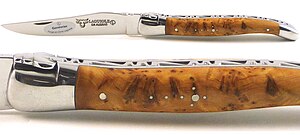Laguiole knife

The Laguiole knife (French pronunciation:
History
The major influence on the form of the classic laguiole is most likely the Arabo-Hispanic clasp knife of
Design




Classic laguiole knives feature a slim, sinuous outline. They are about 12 cm long when closed, with a narrow, tapered blade of a semi-
The traditional laguiole utilizes a single blade, but sometimes a corkscrew or some other implement is added. This necessitates an even slimmer cutaway handle, the shape of which is fancifully known as the "lady's leg", the bolster at the base resembling a foot. A 'Shepherd's Cross' consisting of 6-8 inlaid metal pins forming a cross can be found on the handle of some laguioles. It is a myth that this embellishment is a reference to a legend of Catholic shepherds in need of a cross for prayer during their seasonal migrations between the mountains and the plains. The cross can be found in the knives not earlier than the 1950s and is a mere decoration.[5]
There is much mythology about the insect depicted on the spring. A legend identifies the design as a bee granted by Emperor
There are about 109 production steps for a one-piece laguiole (single blade), about 166 for a two-piece one (blade and one other tool), and about 216 for a three-piece model (blade and two tools - corkscrew and awl).
The name Laguiole has since been used as a trademark designation for various other implements, so that one can now buy, for example, a "Laguiole" corkscrew, spoon, or steak-knife set.
French and overseas production
As laguiole designates a type of knife and is not a brand or trade name of cutlery, laguiole knives are manufactured globally. This has led to the widespread availability of inexpensive, and sometimes low-quality, "laguiole" knives from China and elsewhere. Laguiole knives from France are currently produced in the cutlery town of Thiers, and more recently, production resumed in the village of Laguiole, the knife's namesake. French manufacturers stamp a trademark or signature into the steel of their knives. A description of the type of steel used and "Made in France" will often be stamped as well.
See also
- Opinel knife
- Douk-Douk
References
- ISBN 0-8264-4739-2(2005), p. 151
- ^ a b Lecoutre, Fabien, Rubat, Baptiste, Engelen, Barth, and Engelen, Cécile, Le Petit Futé La France à moto!, Paris, FR: Les Nouvelles Editions l'Université (2008), p. 540
- ISBN 2-84494-858-8(2005), p. 17
- ^ Pierre Pelou, L'arbre et le paysage : L'itinéraire d'un postier rouergat (1907–1981), Editions L'Harmattan, 2011, p. 76
- ^ Christian Lemasson, Histoire du couteau de Laguiole. Monts Auvergne, 2012, p. 53
External links
- History of the Laguiole knife
- The Laguiole knife museum's website Archived 2009-06-24 at the Wayback Machine
- Handcrafting pictures and videos for Laguiole knives
- Manufacturing a Laguiole knife
- Forge de Laguiole - Forge de Laguiole - Manufacturer in the village of Laguiole
- Laguiole Honore Durand - Honore Durand - Manufacturer in the village of Laguiole
- Laguiole French Knives - Manufacturer of Laguiole
